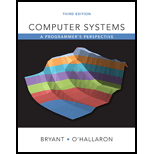
Given Y86-64 code:
.pos 0
irmovq stack, %rsp
call main
halt
.align 8
data:
.quad 0x0000000000000004
.quad 0x0000000000000003
.quad 0x0000000000000002
data_end:
.quad 0x0000000000000001
main:
irmovq data,%rdi
irmovq data_end,%rsi
call ysBubbleP
ret
ysBubbleP:
jmp L2
L4:
mrmovq 8(%rax), %r9
mrmovq (%rax), %r10
rrmovq %r9, %r8
subq %r10, %r8
jge L3
rmmovq %r10, 8(%rax)
rmmovq %r9, (%rax)
L3:
irmovq $8, %r8
addq %r8, %rax
jmp L5
L6:
rrmovq %rdi, %rax
L5:
rrmovq %rsi, %r8
subq %rax, %r8
jg L4
irmovq $8, %r8
subq %r8, %rsi
L2:
rrmovq %rsi, %r8
subq %rdi, %r8
jg L6
ret
.pos 0x200
stack:
Data movement instructions:
- The different instructions are been grouped as “instruction classes”.
- The instructions in a class performs same operation but with different sizes of operand.
- The “Mov” class denotes data movement instructions that copy data from a source location to a destination.
- The class has 4 instructions that includes:
- movb:
- It copies data from a source location to a destination.
- It denotes an instruction that operates on 1 byte data size.
- movw:
- It copies data from a source location to a destination.
- It denotes an instruction that operates on 2 bytes data size.
- movl:
- It copies data from a source location to a destination.
- It denotes an instruction that operates on 4 bytes data size.
- movq:
- It copies data from a source location to a destination.
- It denotes an instruction that operates on 8 bytes data size.
- movb:
Unary and Binary Operations:
- The details of unary operations includes:
- The single operand functions as both source as well as destination.
- It can either be a memory location or a register.
- The instruction “incq” causes 8 byte element on stack top to be incremented.
- The instruction “decq” causes 8 byte element on stack top to be decremented.
- The details of binary operations includes:
- The first operand denotes the source.
- The second operand works as both source as well as destination.
- The first operand can either be an immediate value, memory location or register.
- The second operand can either be a register or a memory location.
Jump Instruction:
- The “jump” instruction causes execution to switch to an entirely new position in program.
- The “label” indicates jump destinations in assembly code.
- The “je” instruction denotes “jump if equal” or “jump if zero”.
- The comparison operation is performed.
- If result of comparison is either equal or zero, then jump operation takes place.
- The “ja” instruction denotes “jump if above”.
- The comparison operation is performed.
- If result of comparison is greater, then jump operation takes place.
- The “pop” instruction resumes execution of jump instruction.
- The “jmpq” instruction jumps to given address. It denotes a direct jump.
Want to see the full answer?
Check out a sample textbook solution
Chapter 4 Solutions
Computer Systems: A Programmer's Perspective Plus Mastering Engineering With Pearson Etext -- Access Card Package (3rd Edition)
- Could you help me to know features of the following concepts: - commercial CA - memory integrity - WMI filterarrow_forwardBriefly describe the issues involved in using ATM technology in Local Area Networksarrow_forwardFor this question you will perform two levels of quicksort on an array containing these numbers: 59 41 61 73 43 57 50 13 96 88 42 77 27 95 32 89 In the first blank, enter the array contents after the top level partition. In the second blank, enter the array contents after one more partition of the left-hand subarray resulting from the first partition. In the third blank, enter the array contents after one more partition of the right-hand subarray resulting from the first partition. Print the numbers with a single space between them. Use the algorithm we covered in class, in which the first element of the subarray is the partition value. Question 1 options: Blank # 1 Blank # 2 Blank # 3arrow_forward
- 1. Transform the E-R diagram into a set of relations. Country_of Agent ID Agent H Holds Is_Reponsible_for Consignment Number $ Value May Contain Consignment Transports Container Destination Ф R Goes Off Container Number Size Vessel Voyage Registry Vessel ID Voyage_ID Tonnagearrow_forwardI want to solve 13.2 using matlab please helparrow_forwarda) Show a possible trace of the OSPF algorithm for computing the routing table in Router 2 forthis network.b) Show the messages used by RIP to compute routing tables.arrow_forward
- using r language to answer question 4 Question 4: Obtain a 95% standard normal bootstrap confidence interval, a 95% basic bootstrap confidence interval, and a percentile confidence interval for the ρb12 in Question 3.arrow_forwardusing r language to answer question 4. Question 4: Obtain a 95% standard normal bootstrap confidence interval, a 95% basic bootstrap confidence interval, and a percentile confidence interval for the ρb12 in Question 3.arrow_forwardusing r languagearrow_forward
 C++ Programming: From Problem Analysis to Program...Computer ScienceISBN:9781337102087Author:D. S. MalikPublisher:Cengage Learning
C++ Programming: From Problem Analysis to Program...Computer ScienceISBN:9781337102087Author:D. S. MalikPublisher:Cengage Learning C++ for Engineers and ScientistsComputer ScienceISBN:9781133187844Author:Bronson, Gary J.Publisher:Course Technology Ptr
C++ for Engineers and ScientistsComputer ScienceISBN:9781133187844Author:Bronson, Gary J.Publisher:Course Technology Ptr New Perspectives on HTML5, CSS3, and JavaScriptComputer ScienceISBN:9781305503922Author:Patrick M. CareyPublisher:Cengage Learning
New Perspectives on HTML5, CSS3, and JavaScriptComputer ScienceISBN:9781305503922Author:Patrick M. CareyPublisher:Cengage Learning- Programming Logic & Design ComprehensiveComputer ScienceISBN:9781337669405Author:FARRELLPublisher:Cengage
 EBK JAVA PROGRAMMINGComputer ScienceISBN:9781337671385Author:FARRELLPublisher:CENGAGE LEARNING - CONSIGNMENT
EBK JAVA PROGRAMMINGComputer ScienceISBN:9781337671385Author:FARRELLPublisher:CENGAGE LEARNING - CONSIGNMENT Microsoft Visual C#Computer ScienceISBN:9781337102100Author:Joyce, Farrell.Publisher:Cengage Learning,
Microsoft Visual C#Computer ScienceISBN:9781337102100Author:Joyce, Farrell.Publisher:Cengage Learning,





